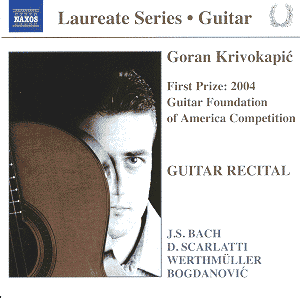Goran Krivokapić,
born in Belgrade in 1979, is fast establishing himself as one
of the finest guitarists of his generation. He has already won
prizes at just about every international guitar competition
you can name. I have a tendency to fall asleep at guitar recitals,
but Krivokapić’s commanding technique makes you sit up
and pay attention right from the start.
The amount of transcriptions
on this CD are disclaimed with a quote from Ferruccio Busoni
in the booklet notes, ‘Good, great and universal music remains
the same no matter what instrument sounds the notes.’ Well,
we can argue about whether it actually ‘remains the same’, but
what Busoni means, and where we are in agreement, is that such
music is equally valid on virtually any instrument. There is
of course a reason why there are few such transcriptions for,
say, Scottish bagpipes or the Mississippi steamboat calliope,
but again that is to wilfully miss the point. Krivokapić
makes as good a case for Bach and Scarlatti on guitar as I can
imagine.
The recital begins
with a less familiar name, Franz Werthmüller. Very classical
in orientation, the idiom is Haydnesque, but there are some
gorgeous ringing harmonics; a technical effect which at times
provides a kind of unwitting polytonality. The Sonata’s origins
are surmised to have been as a work for piano, but Pfeifer’s
transcription is apparently all that survives. There is a small
technical foible with Krivokapić’s which reveals itself
in the central Largo movement of this piece. A
side effect of wound guitar strings, there is always a certain
amount of squealing from the left hand with the modern guitar.
We sometimes get extra notes as well however, and at 3:36 in
this slow movement, and 0:53 into the final Presto we
get quite a ‘wannngg’. Such things are incidental, and
proof of the physical nature of instrumental performing – like
the heavy breathing which is also in evidence.
The opening Sonata
is a fresh-sounding and interesting work, which is followed
by Krivokapić’s own Bach transcription of the BWV 1005
solo violin sonata. My own feeling about string-to-guitar transcriptions
of Bach is that the stresses and tensions inherent in double-stopping
and leaping, spread chords is lost, to the extent that I go
back to sleep quite quickly. Krivokapić’s playing is persuasive
however, with quite a rich, punchy tone, keeping the whole thing
alive and dynamic. His voicing in the extensive counterpoint
is impeccable, and he seems able to get inside the music in
a way I’ve often felt missing in other versions.
The same can be
said of Krivokapić’s playing of the Scarlatti Sonatas.
Transcribed from harpsichord instead of violin of course, they
present different technical problems, but the Spanish aspects
of Scarlatti’s creativity become amply present in such versions
for guitar. There is the gentle dissonance of the opening of
K. 162, the cantabile expressiveness of K. 208 and the
incandescent K. 209, all played with equal brilliance.
The most exciting
piece on this disc for me is the 1985 Sonata by Goran Krivokapić’s
fellow countryman Dušan Bogdanović. As a composer for guitar,
Bogdanović’s name is becoming increasingly recognised –
cropping up on concert programmes all over Europe, and justly
so. There are few composers writing new music for guitar which
is rewarding for player and public alike, and Bogdanović
knows his way around the guitar like a cat. There are some marvellously
inventive moments like the ending of the second Adagio molto
espressivo movement, which harks a little towards something
Ralph Towner might have improvised. Deceptive and tricky, the
Scherzo malinconico is a feast for the receptive mind,
and the final Allegro ritmico contrasts the advertised
rhythmic elements with interesting harmonic twists of which
even Frank Martin might have been proud.
Goran Krivokapić’s
guitar is beautifully recorded here, bathing in a resonant church
acoustic, but with close microphones pointing out every last
ounce of detail. There is no real background noise, but sensitive
listeners will notice a very distant rumble of traffic in quiet
passages – something which must be almost unavoidable these
days. Again, Naxos have supplied us a CD which is many things
to many people: a must for guitarists, of great interest to
seekers of new and stimulating repertoire and a recording of
demonstration quality for those who have blown all their cash
on expensive Hi-Fi, and who now can’t afford full priced discs.
Dominy Clements
see also Reviews
by Jonathan Woolf and Göran
Forsling

![]() Goran Krivokapić (guitar)
Goran Krivokapić (guitar)![]() NAXOS 8.557809
[61:11]
NAXOS 8.557809
[61:11]